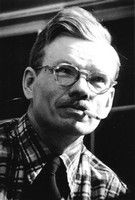Kenneth Stubbs |
 |
Kenneth Stubbs |
 |
|
The Show Isn't Up to Its SettingNever the time and the place and the talents all ingeniously combined to make the perfect whole. Often in Washington, and more particularly in the past than now when the display facilities have improved, it was a case of the setting letting down the exhibitors. This time, we feel it is the exhibit which fails to live up to the setting. The Artists Guild of Washington and the Washington Sculptors Group have staged a summer show, jointly, under sponsorship of the American Institute of Architects, in the garden and gallery of the Octagon, the institute's national headquarters. Once more, as it was last year, the garden is bedecked with sculpture. Twenty-five pieces all told, a few of them displayed indoors, were chosen by a jury consisting of architects Julian E. Berla (who acted as chairman) and Nicholas Satterlee with the aid of Miss. Cary Milholland, landscape architect who designed the AIA garden. Upstairs in the gallery (in the office headquarters, not in the Octagon itself, which is a historic landmark and was furnished and opened to the public by the AIA about a year ago) are some 34 water colors, drawings and prints by members of the Artists Guild, chosen by their own committee composed of Peter Blanc, now president of the guild; Frances Ferry, Russell Houston, Helen Rennie and Prentiss Taylor. This is the first time the two Washington artists' groups have exhibited together. Although both are mere babes by comparison with the venerable Society of Washington Artists, the guild is the senior of the sculptors group by quite some years, in fact is celebrating its tenth birthday this fall. It was a war baby, originating around the time of Pearl Harbor, with the aim of linking the artists for the common purpose of making their talents available to help the war effort and to help keep the arts alive and present a united front as an exhibiting body at the same time. The current show is not a fair test of what has happened to the guild during the intervening years of peace or semipeace. Some of the brightest stars, often for reasons they could not help, are not represented; others, whatever the reason, seem not to have put their best work forward. The show is confined to what are generally considered the lighter media and oils are banished, like winter woolens, for the season. On the whole, it seems to us that the drawings and gouaches, which present the more opaque side of water color, are stronger than the latter medium in its purest form. Pietro Lazzari's sketch of "Park Politicians" is a delight, as is Sarah Baker's "Mother and Child." Other highly pleasurable drawings include Kenneth Stubbs' two clear-cut black-and-whites and Marguerite Burgess' free-wheeling birds. Samuel Bookatz has an impressive gouache, "We Stand Alone," in which the foregound figure is purposely overwhelmed by a background rich in color; somewhat similar in the composition arrangement is Barbara Ferrell's "Monument to the Past," an entry that has much to offer. Arresting in lithographic crayon is Harold Giese's "Girl with Kite." Among the prints, Jack Perlmutter's "National Airport," a tour de force with broad black areas splashed with white, Jacob Kainen's "Odyssey" and Laura Douglas' "All God's Children" stand out. Even more conspicuous are the missing among the sculpture entrants. The show unfortunately has the air of having been hastily gathered and dropped there, rather than of occupying the spaces as if they belonged there, which is doubly a pity, for it could be such magnificent propaganda in a garden-minded community for the addition of sculpture among green-growth and flowers. Outstanding are two pieces in alabaster, a lovely medium in itself. Indoors and upstairs Alice Decker's "Cockatoos" are a notable inclusion--perhaps the most distinguished single entry in the show. Near the garden entrance is "Florence Higgs' "Girl with Cockatoo," another gem. But this display holds more than cockatoos. There are a number of winning animal, insect and fish carvings, for the most part in the rough hewn down-to-earth vein so miraculously presented by the late John. B. Flanagan. Hazel van Natter, as usual, has at least one notable entry (her polished wood carvings appear in the entrance hall downstairs). Gay and decorative are Katherine Hobbs' works in terra cotta, including a circus horse, a story-book horse and rider and the Zoo's prized baby elephants. Fine for a garden would be Belle Bellerose's "Garden Friend" or George Glenn's "Grasshopper." We liked the character in Minnie Barz' animal figures, the dignity of Russell Houston's "Three Brothers" and Donald Kline's prophet, the grace in Katherine Sater's varied contributions. But the display would have greatly profited from some larger pieces. And we missed inclusions by such previous exhibitors as Clare Fontanini and others of Catholic University, Lilli Gettinger, Maxim Elias. The good news is that some of the missing are working on commissions. Incidentally, a practical joker has added an entry of his own. Placed inconspicuously on a line with the legitimate entries is a small block with a bump at one side (could it be a carving?) and under the caption neatly inscribed: "Life's Imperfection." All in the spirit (we hope) of good clean fun. Jane Watson Crane, Washington Post, June 24, 1951, page 5L
|
See also: Show Announcement Washington Star Review |